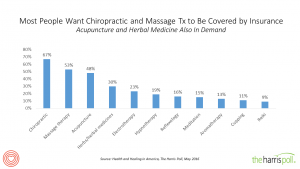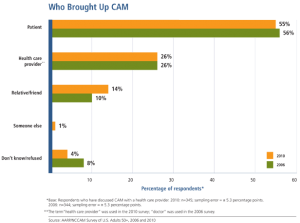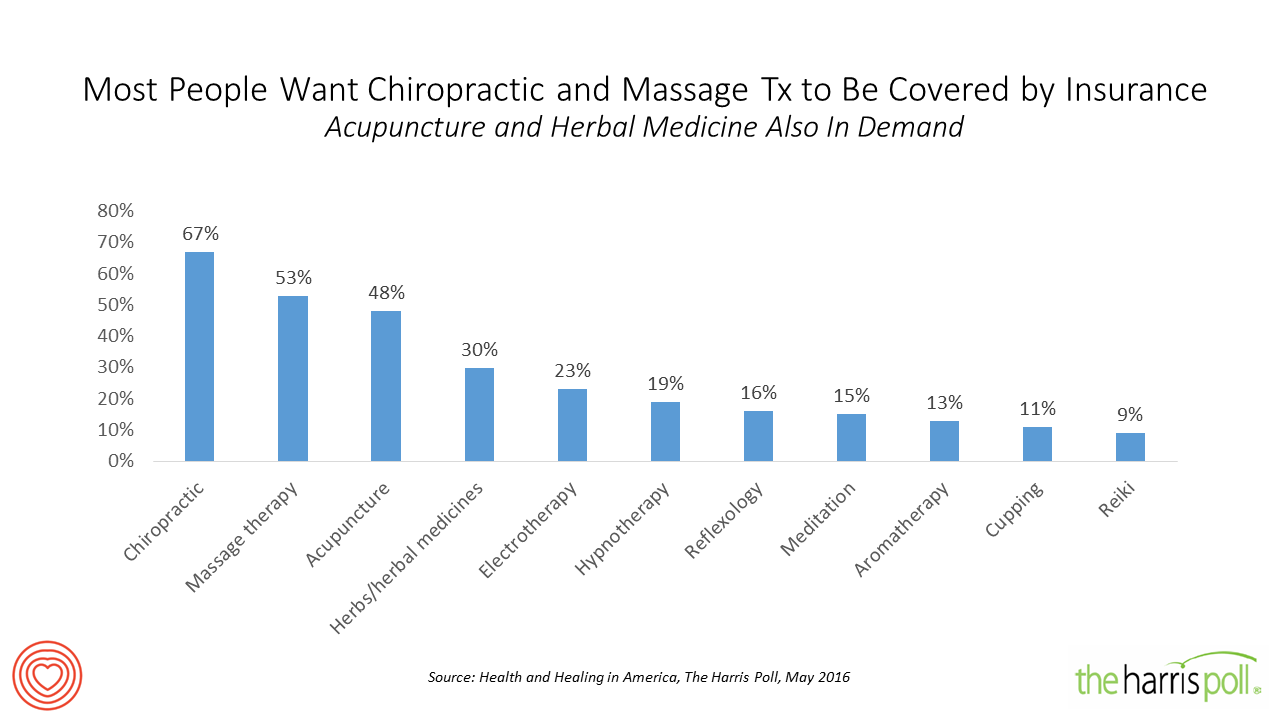 Faced with the increasing financial responsibility for healthcare payments, and a desire to manage pain and disease via “natural” approaches, more U.S. consumers are seeking and paying for non-conventional or naturopathic therapies — complementary and alternative medicine (CAM).
Faced with the increasing financial responsibility for healthcare payments, and a desire to manage pain and disease via “natural” approaches, more U.S. consumers are seeking and paying for non-conventional or naturopathic therapies — complementary and alternative medicine (CAM).
Health and Healing in America, The Harris Poll conducted among U.S. adults, learned that two in three Americans see alternative therapies as safe and effective. 1 in 2 people see alternative therapies as reliable. And most people believe that some of these treatments, like chiropractic and massage therapy, should be reimbursed by health insurance companies.
Seven in 10 Americans have used alternative therapy in their lifetime, the most common treatments being herbal medicines and chiropractic care. Nearly one-half of “Matures” (people 70 years of age and over) have used chiropractic.
But it’s Millennials who appear the growing demand force in the Harris survey. One in 4 Millennials (25%) are using alternative therapies more than they are conventional medicine, compared with 5% of Matures.
The top use of alternative therapies is for pain, in this era of growing opioid use and abuse.
The Harris Poll was conducted online among 2,252 adults in December 2016.
 Health Populi’s Hot Points: The Harris Poll analysts expect to see greater uptake of self-care and alternative treatments, anticipating the continued trends toward high-deductible health plans and DIY healthcare among consumers.
Health Populi’s Hot Points: The Harris Poll analysts expect to see greater uptake of self-care and alternative treatments, anticipating the continued trends toward high-deductible health plans and DIY healthcare among consumers.
Most consumers, patients, raise the issue of CAM to their providers — not providers-to-patients, shown in the second graph. This data point comes from a landmark survey on U.S. consumers and CAM conducted in 2010 between AARP and the National Center for Complementary and Integrative Health (NCCAM) among people 50 years of age and over.
That research found that a majority of older Americans used complementary and alternative medicine. Over one-third was taking some kind of herbal product or dietary supplement. But only 1 in 3 older adults, and just over one-half of CAM users, said they have ever discussed CAM with their doctors.
Today, I consulted the UpToDate synthesis of evidence for CAM on cancer, which is a patient population with growing demand for alternatives to expensive and toxic specialty drugs/therapies. I note that the last time the IOM published a report on CAM was 2005, and the Institute has called to convene a group to update this work. However, the link for “more information” on this topic was broken, so it is uncertain just when IOM will follow this up.
There’s a big gap between health consumers in the high-deductible era and their physicians when it comes to CAM. People want to manage their illness and financial wellness, and many people in self-care/health DIY mode consume herbal remedies, chiropractic services, mindful meditation, and other services and products — particularly to manage pain and sleep, another epidemic issue facing a plurality of American health citizens. Patients-as-consumers need more evidence-based information on which to make decisions, and among those treatments that can serve people with pain, sleeplessness, depression, among other clinical challenges, health insurance reimbursement can help ameliorate clinical issues and financial stress.





 Interviewed live on BNN Bloomberg (Canada) on the market for GLP-1 drugs for weight loss and their impact on both the health care system and consumer goods and services -- notably, food, nutrition, retail health, gyms, and other sectors.
Interviewed live on BNN Bloomberg (Canada) on the market for GLP-1 drugs for weight loss and their impact on both the health care system and consumer goods and services -- notably, food, nutrition, retail health, gyms, and other sectors. Thank you, Feedspot, for
Thank you, Feedspot, for  As you may know, I have been splitting work- and living-time between the U.S. and the E.U., most recently living in and working from Brussels. In the month of September 2024, I'll be splitting time between London and other parts of the U.K., and Italy where I'll be working with clients on consumer health, self-care and home care focused on food-as-medicine, digital health, business and scenario planning for the future...
As you may know, I have been splitting work- and living-time between the U.S. and the E.U., most recently living in and working from Brussels. In the month of September 2024, I'll be splitting time between London and other parts of the U.K., and Italy where I'll be working with clients on consumer health, self-care and home care focused on food-as-medicine, digital health, business and scenario planning for the future...